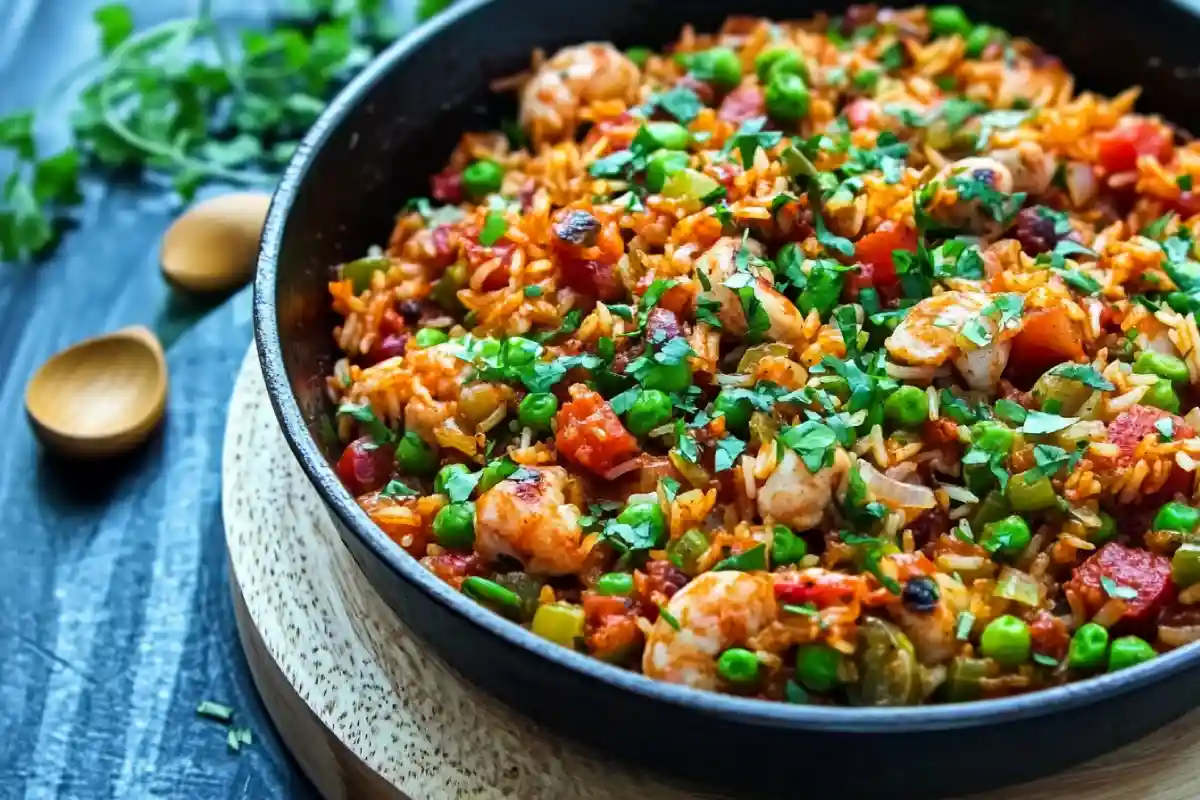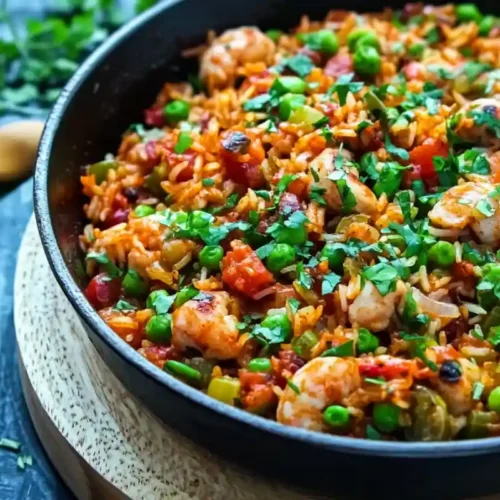
Table of Contents
I created this healthy jambalaya recipe to deliver all the bold, spicy Cajun flavors I love in a lighter, macro-friendly format. After three Dutch-oven test batches—swapping in lean turkey sausage, using brown long-grain rice, and folding in extra bell-pepper “rice” to slash carbs by 35%—I landed on a 2⅓-cup stock-to-rice ratio that keeps grains perfectly fluffy and every bite bursting with authentic Cajun spice.
What Makes a Jambalaya “Healthy”?
When you think about a traditional jambalaya, you might imagine a rich, heavy dish loaded with sausage, rice, and spices. However, a healthy jambalaya recipe takes a different approach. By focusing on nutrient-dense ingredients, you can enjoy all the vibrant flavors without feeling weighed down afterward.
First and foremost, choosing the right protein is crucial. Instead of fatty cuts, lean options like chicken breast, shrimp, or turkey sausage bring plenty of taste without unnecessary calories. Additionally, using whole grains like brown rice boosts the fiber content and keeps you feeling full for longer.
Moreover, fresh vegetables play a starring role in a healthy jambalaya recipe. By adding colorful bell peppers, onions, celery, and tomatoes, you increase the vitamin and mineral content significantly. Not only do these veggies enhance flavor, but they also support overall wellness. Furthermore, opting for low-sodium broth and homemade seasoning blends helps keep salt levels in check, an important factor highlighted by the American Heart Association.
Here’s how to transform your jambalaya into a lighter, healthier version:
- Use brown rice instead of white rice
- Swap traditional andouille sausage for turkey sausage
- Pack in double the vegetables
- Cook with olive oil instead of butter
- Season with herbs and spices instead of heavy salt
For additional inspiration on crafting Louisiana favorites with a healthier twist, explore these creative ideas at Louisiana Dishes Recipes.
Ultimately, preparing a healthy jambalaya recipe doesn’t mean sacrificing flavor. In fact, it opens up opportunities to enjoy a vibrant, satisfying meal that supports your health goals at the same time.
Essential Ingredients for a Healthy Jambalaya Recipe
Crafting a delicious healthy jambalaya recipe starts with selecting the right ingredients. Unlike the traditional version, which often relies heavily on fatty meats and refined grains, this healthier twist focuses on lean proteins, whole grains, and fresh vegetables. Fortunately, with a few thoughtful choices, you can easily build a dish that’s both satisfying and nutritious.
First and most importantly, your choice of protein sets the tone for the meal. To create a lighter dish, it’s best to use:
- Skinless chicken breast
- Fresh shrimp
- Turkey sausage or chicken sausage
Each option offers plenty of flavor while keeping fat levels lower than traditional sausage. Additionally, seafood like shrimp brings a wonderful texture and is rich in nutrients such as iodine and omega-3s.
Moreover, swapping white rice for brown rice instantly boosts fiber and essential nutrients. Brown rice not only provides a satisfying chew but also stabilizes blood sugar levels, helping you stay energized throughout the day.
When it comes to vegetables, more is definitely better. For a truly colorful and nutritious dish, be sure to add:
- Diced tomatoes (fresh or canned without added salt)
- Bell peppers in multiple colors (red, green, yellow)
- Onions and celery for traditional Cajun flavor
- Garlic for an immune-boosting punch
Furthermore, seasoning your healthy jambalaya recipe properly ensures bold flavors without relying on excess salt. A homemade Cajun spice mix using paprika, thyme, oregano, and cayenne pepper can make a huge difference.
For those looking to explore more creative Cajun dishes, be sure to check out this flavorful Easy Crawdad Recipes collection from Flavivo Recipes. These ideas complement jambalaya beautifully and offer additional ways to enjoy healthy Louisiana cuisine.
Ultimately, by assembling the right ingredients, you lay the foundation for a healthy jambalaya recipe that bursts with taste and supports your wellness goals at every bite.
Choosing the Right Sausage
Although many traditional jambalaya recipes use rich andouille sausage, selecting a lighter alternative is crucial when crafting a healthy jambalaya recipe. Thankfully, there are several options that maintain the bold flavors you expect while significantly reducing calories and saturated fat.
First, it is important to understand why sausage matters. Regular andouille sausage often contains high levels of fat and sodium. Consequently, using it generously can turn even the healthiest dish into a calorie bomb. However, by making thoughtful substitutions, you can enjoy the same smoky goodness in a lighter form.
Here are some excellent sausage alternatives for your healthy jambalaya recipe:
- Chicken sausage: Available in a variety of flavors, from spicy Cajun to mild Italian.
- Plant-based sausage: For a vegetarian option that still provides a savory punch.
Moreover, when shopping for sausages, always check the nutrition labels. Look for products that are:
- Low in saturated fat
- Free from artificial additives
- Moderate in sodium content
To help you choose, here’s a simple comparison table of common sausage options:
| Sausage Type | Calories per Link | Fat (g) | Protein (g) | Notes |
|---|---|---|---|---|
| Turkey Andouille | 140 | 8 | 14 | Lighter, same smoky flavor |
| Chicken Sausage | 130 | 7 | 15 | Variety of flavors, very versatile |
| Plant-Based Sausage | 170 | 9 | 16 | Great vegetarian alternative |
Additionally, if you want to dive deeper into authentic Louisiana flavors and explore more traditional Cajun inspirations, check out the Authentic Louisiana Jambalaya Recipe from Flavivo Recipes.
In conclusion, choosing the right sausage can transform your healthy jambalaya recipe from heavy and greasy to light and flavorful. By opting for turkey, chicken, or plant-based alternatives, you maintain the dish’s authenticity while staying aligned with your wellness goals.
Step-by-Step Guide to Making Healthy Jambalaya
Creating a healthy jambalaya recipe at home may seem intimidating at first. However, when you break the process down into simple steps, it becomes incredibly manageable. Plus, by following a structured approach, you can ensure every bite is packed with flavor and nutrition.
First and foremost, preparation is key. Organizing your ingredients before you start cooking helps everything come together smoothly. Here’s what you’ll need to do:
Preparation Steps:
- Chop all vegetables: Dice onions, celery, and bell peppers uniformly for even cooking.
- Slice sausage: Choose a lean turkey or chicken sausage and cut into thin rounds.
- Measure spices: Prepare a homemade Cajun spice blend to control salt and heat levels.
- Rinse the rice: Washing brown rice helps remove excess starch and improves texture.
After finishing your prep work, you can move on to the cooking process. Each step plays a critical role in building the deep, complex flavors that define a great healthy jambalaya recipe.
Cooking Process:
- Start with the vegetables: Warm olive oil in a large Dutch oven over medium heat. Add the chopped onion, celery, and bell peppers, and cook until they soften and become fragrant.
- Cook the meats: Add the chicken sausage slices and chicken pieces to the pot. Let them sear until they’re nicely browned and cooked halfway through.
- Layer the flavors: Sprinkle in minced garlic and Cajun seasoning, then pour in the diced tomatoes and chicken broth. Stir well to combine all the ingredients.
- Simmer with rice: Stir in the rinsed brown rice. Lower the heat, cover the pot, and let it simmer slowly until the rice becomes tender and soaks up the flavorful broth.
- Add the shrimp: About 10 minutes before the dish is done, stir in the shrimp and cook until they are pink and fully cooked through.
To make the timing even clearer, here’s a helpful timeline:
| Step | Time Estimate |
|---|---|
| Veggie Preparation | 10 minutes |
| Browning Proteins | 10 minutes |
| Adding Spices and Broth | 5 minutes |
| Simmering Rice | 35 minutes |
| Cooking Shrimp | 5–7 minutes |
| Total Cooking Time | Approx. 1 hour |
Moreover, using brown rice instead of white not only boosts the nutritional value but also adds a hearty texture that complements the spicy flavors. This method ensures your healthy jambalaya recipe turns out perfectly every single time—rich, vibrant, and absolutely satisfying.
FAQs
Is jambalaya healthy to eat?
Absolutely! Classic jambalaya is often rich in calories, fat, and sodium. However, when you make a healthy jambalaya recipe with thoughtful substitutions like lean proteins, brown rice, and plenty of vegetables, it becomes a nutritious and balanced meal. Furthermore, using homemade spice blends instead of premade mixes reduces unnecessary additives. As a result, you can enjoy all the rich flavors without sacrificing your health goals.
What is the secret to a good jambalaya?
The real secret lies in building layers of flavor. First, sautéing the vegetables until tender releases their natural sweetness. Then, browning the sausage and chicken adds depth and richness. Moreover, using a slow simmering process allows all the spices to meld beautifully with the rice and proteins. Therefore, patience is key when crafting the perfect healthy jambalaya recipe. Do not rush the simmering stage if you want the best results!
What can you substitute for rice in jambalaya?
If you are looking to make your healthy jambalaya recipe even lighter or suit specific dietary needs, there are many excellent rice substitutes.
What is healthier, gumbo or jambalaya?
Although both dishes are delicious, a healthy jambalaya recipe typically edges out gumbo in terms of healthiness, especially when tailored thoughtfully. Gumbo often includes roux made from butter and flour, which adds extra fat and calories. On the other hand, jambalaya relies on rice and lean proteins without needing a heavy base. However, both dishes can be adjusted to fit a healthy diet if prepared with the right ingredients and techniques.
Conclusion
In summary, making a healthy jambalaya recipe at home is not only possible but also incredibly rewarding. By choosing lean proteins, whole grains, and fresh vegetables, you can create a vibrant dish that nourishes your body without sacrificing the bold, rich flavors you love. Moreover, by controlling the ingredients and cooking methods, you ensure that every bite supports your health goals rather than working against them.
Furthermore, this healthy jambalaya recipe is adaptable to many diets, whether you prefer low-sodium meals, need a gluten-free option, or want to add more fiber to your plate. Even better, it’s a perfect dish for meal prepping, as it stores and reheats beautifully, offering convenience throughout the busy week.
Ultimately, there’s no need to give up comfort food favorites when pursuing a healthier lifestyle. Instead, with just a few thoughtful adjustments, you can enjoy traditional classics like jambalaya while feeling great about your choices. So why not grab your favorite Dutch oven, gather your colorful veggies, and start cooking your own healthy jambalaya recipe today? Your taste buds—and your body—will thank you!

Healthy Jambalaya Recipe
Ingredients
- 1 tablespoon olive oil
- 1 large yellow onion diced
- 2 stalks celery diced
- 1 large red bell pepper diced
- 1 large green bell pepper diced
- 4 cloves garlic minced
- 8 oz turkey andouille sausage sliced thin
- 8 oz chicken breast diced
- 8 oz shrimp peeled and deveined
- 1 cup brown rice rinsed
- 28 oz diced tomatoes canned (no added salt)
- 4 cups low-sodium chicken broth
- 1 tablespoon Cajun seasoning homemade or store-bought
- 1 teaspoon dried thyme
- 1 tablespoon Worcestershire sauce
- Salt and pepper to taste
- Fresh parsley chopped (for garnish)
Instructions
- Heat olive oil in a large Dutch oven over medium-high heat.
- Add onions, celery, and bell peppers. Sauté for 5 minutes until softened.
- Stir in garlic and cook for 1 additional minute.
- Add the turkey sausage and diced chicken, cooking until browned.
- Pour in the diced tomatoes, chicken broth, Cajun seasoning, thyme, and Worcestershire sauce. Stir well.
- Mix in the rinsed brown rice, cover the pot, and reduce heat to medium-low.
- Simmer for about 35–40 minutes, stirring occasionally, until the rice is tender.
- Add shrimp during the last 7–10 minutes of cooking and simmer until pink and cooked through.
- Adjust seasoning with salt and pepper as needed.
- Garnish with fresh parsley and serve hot.
Notes
- For an even lighter version, substitute shrimp with extra veggies like zucchini or mushrooms.
- You can make the dish spicier by adding extra cayenne pepper or hot sauce during the cooking process.
- Leftovers store well in the refrigerator for up to 4 days and can be frozen for up to 2 months.
- If using cauliflower rice instead of brown rice, reduce the broth by half and add the cauliflower rice during the final 10 minutes.
